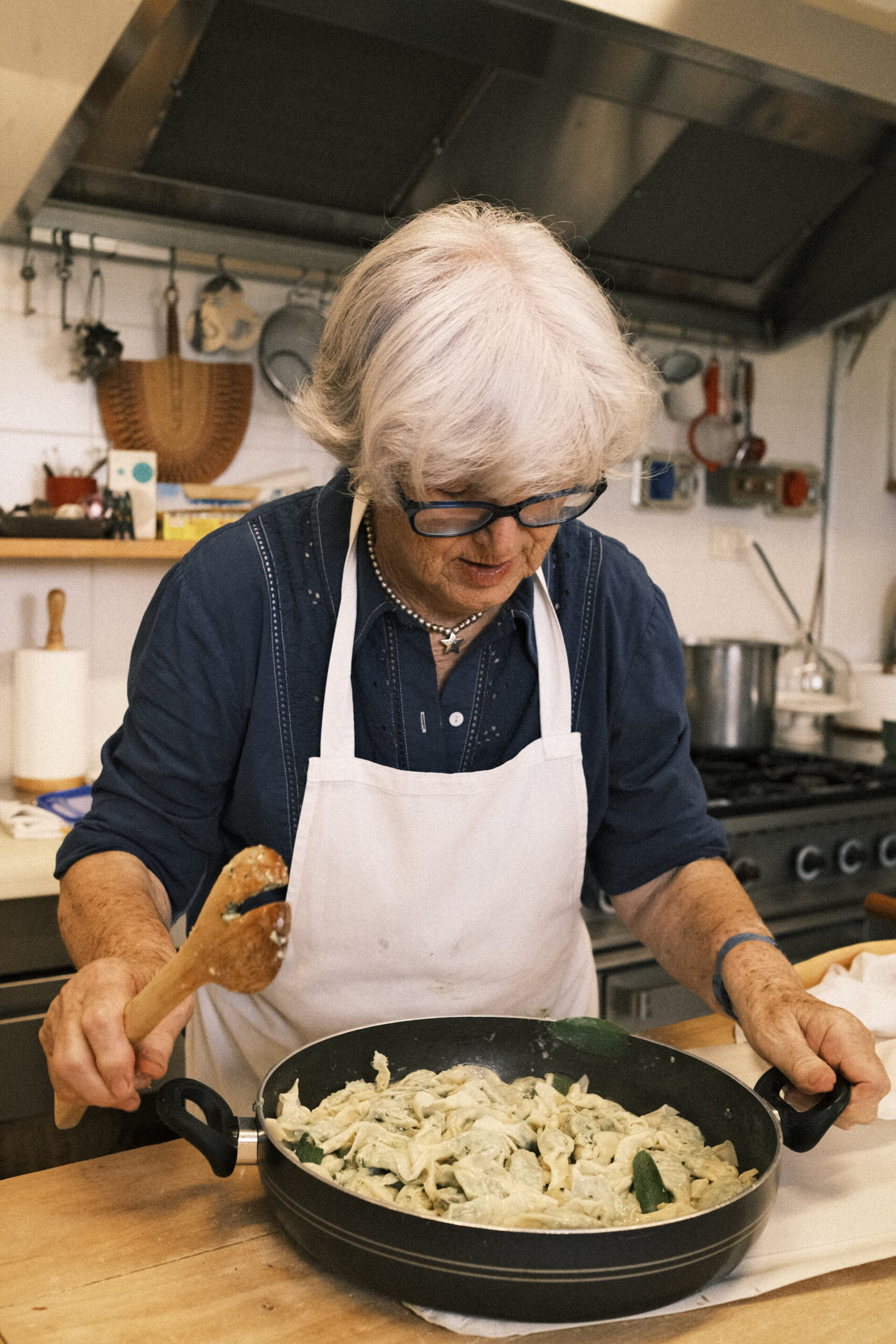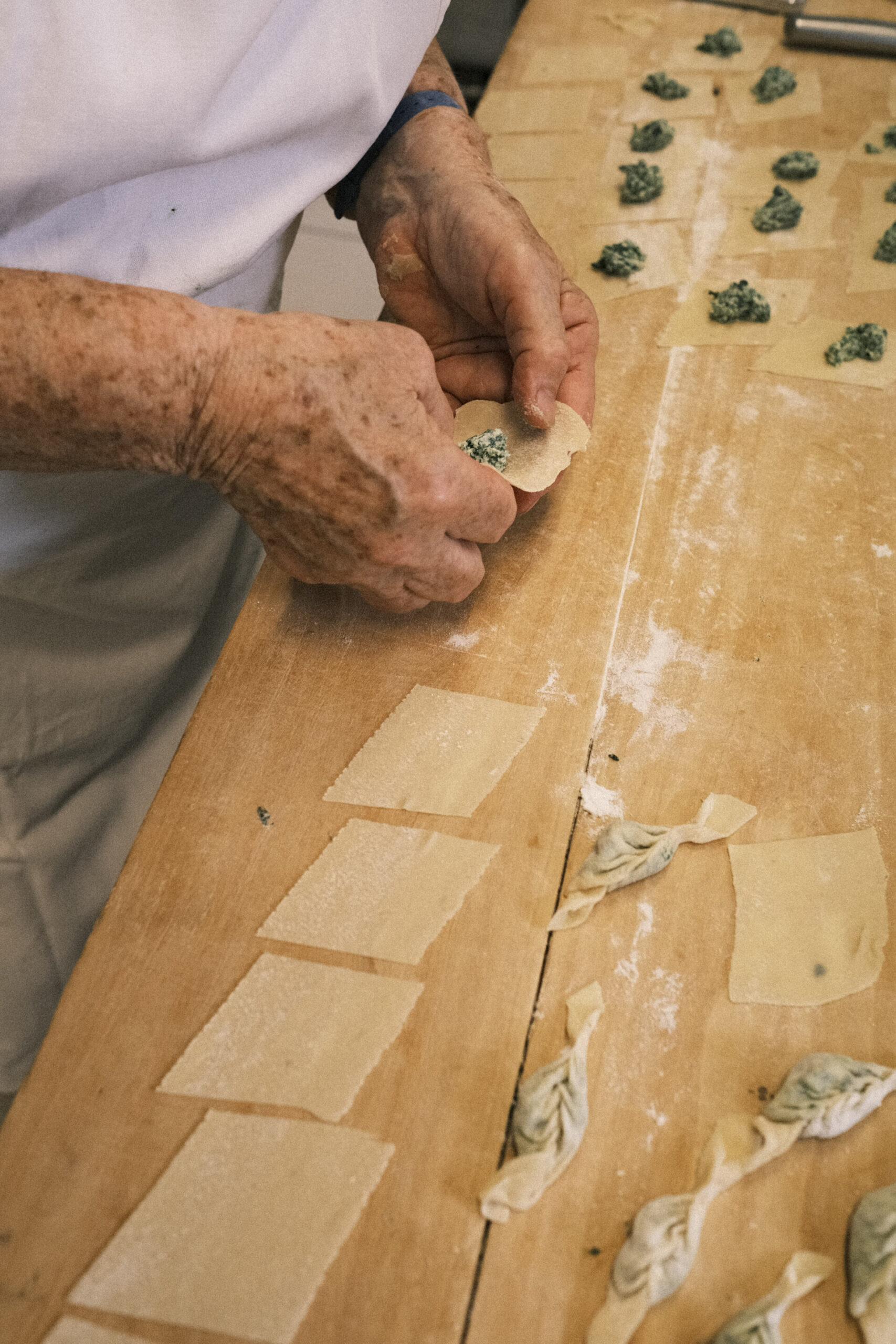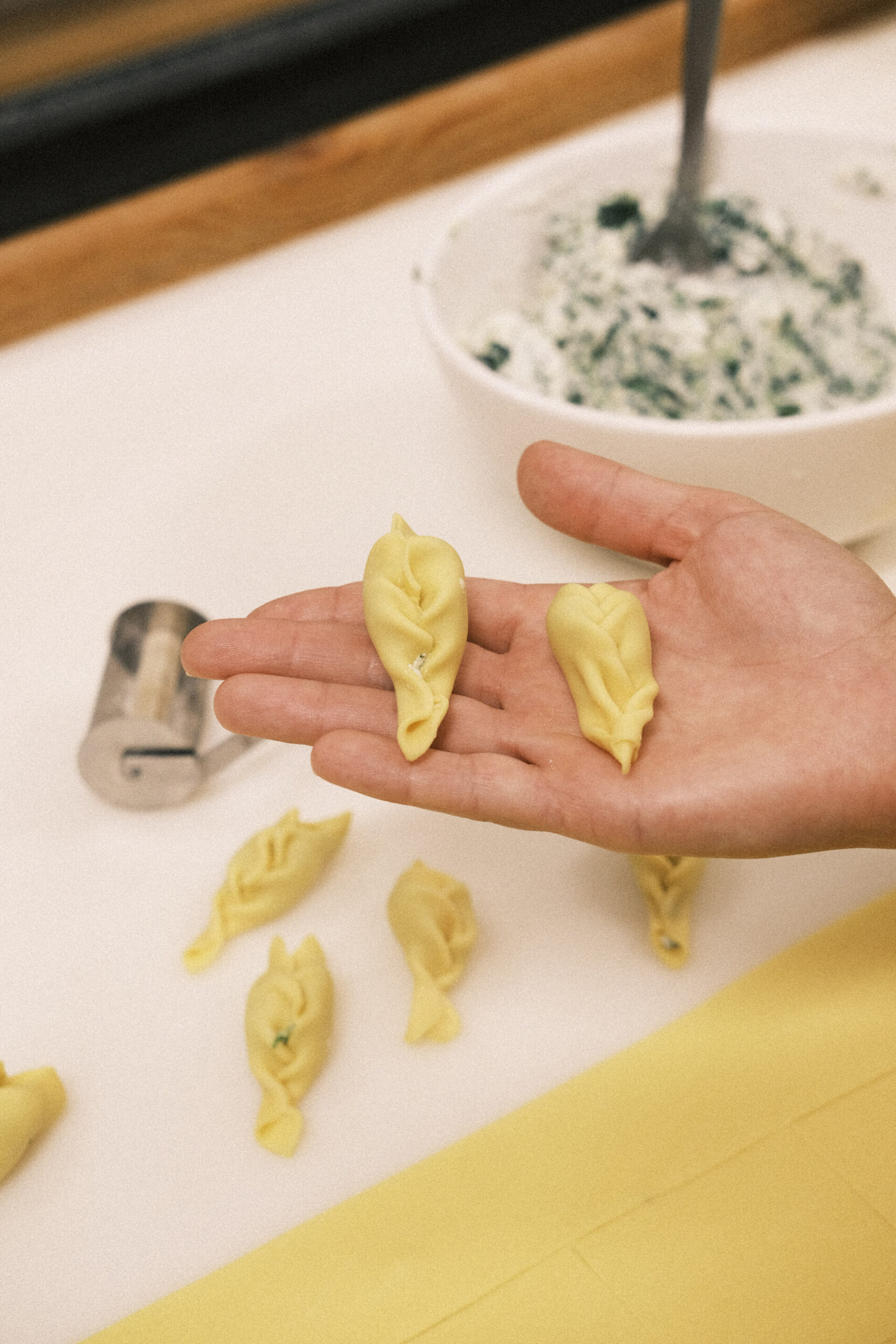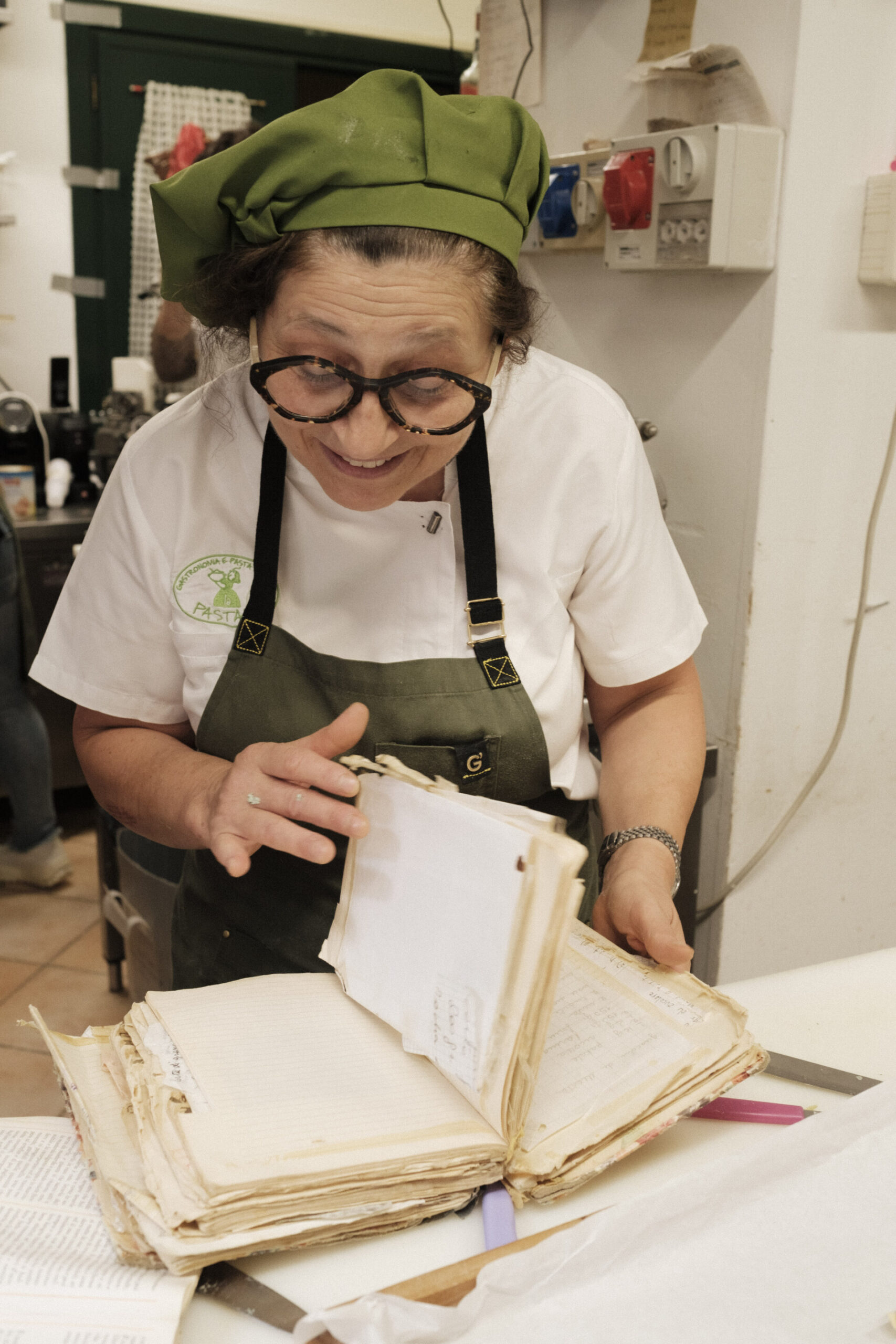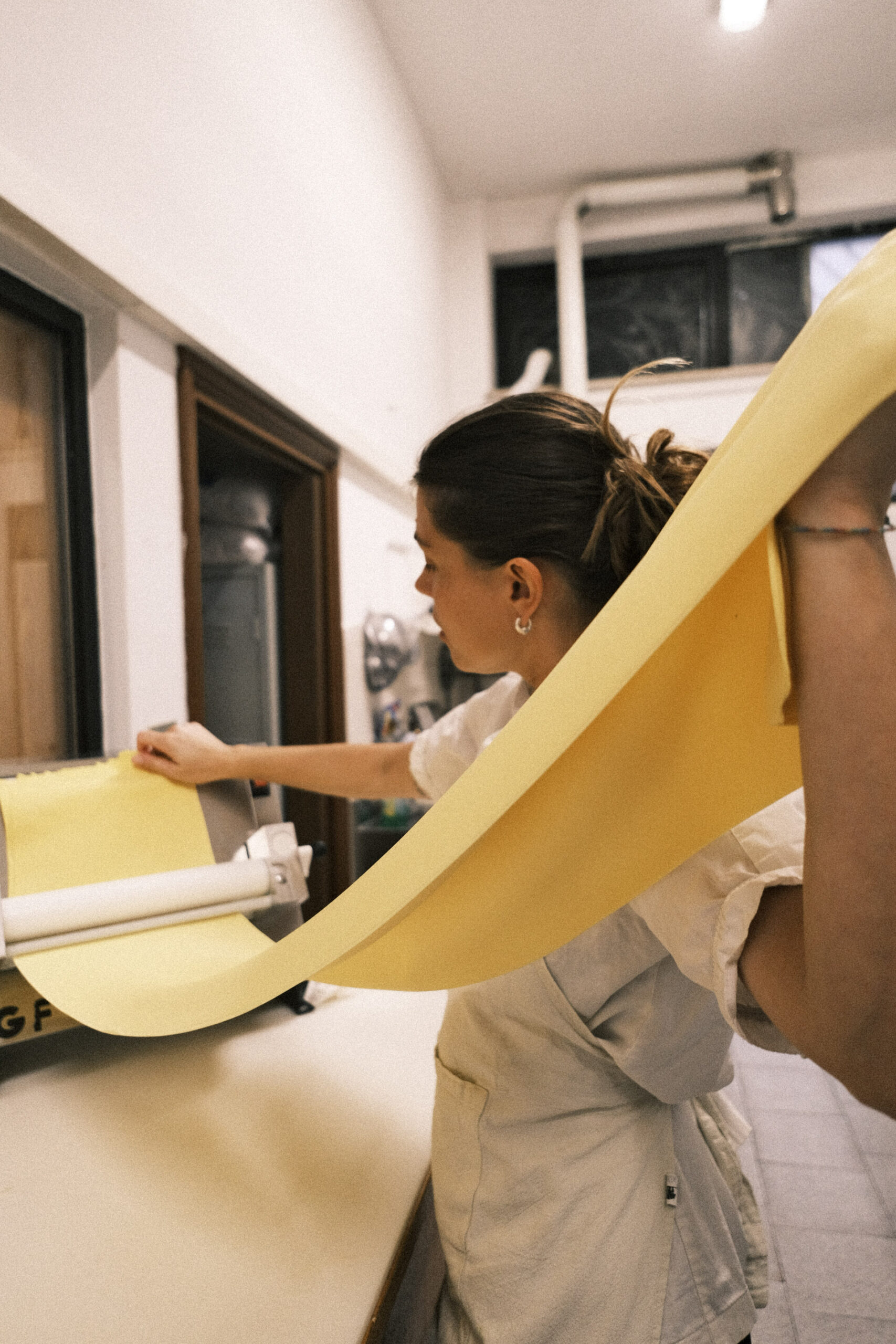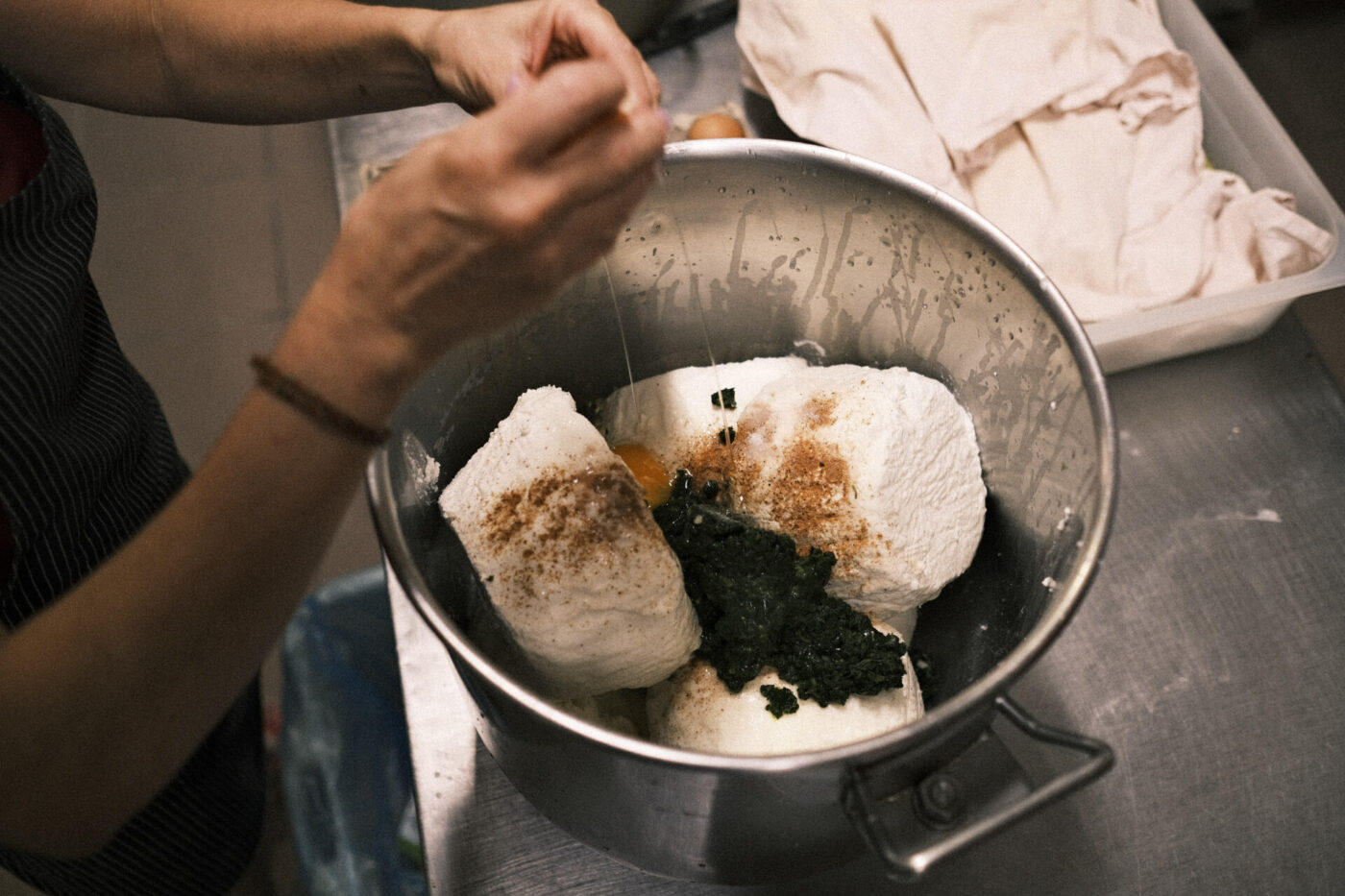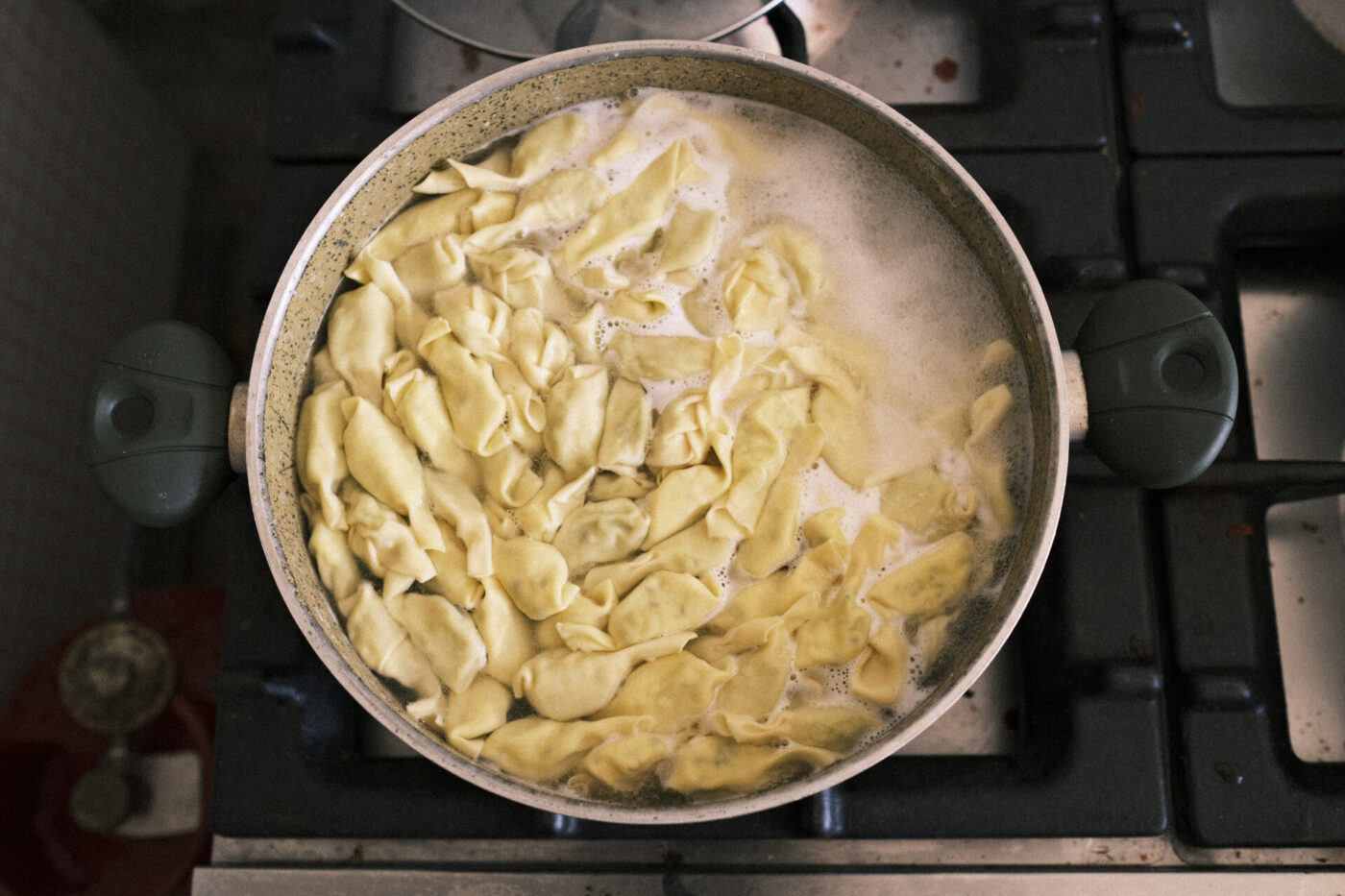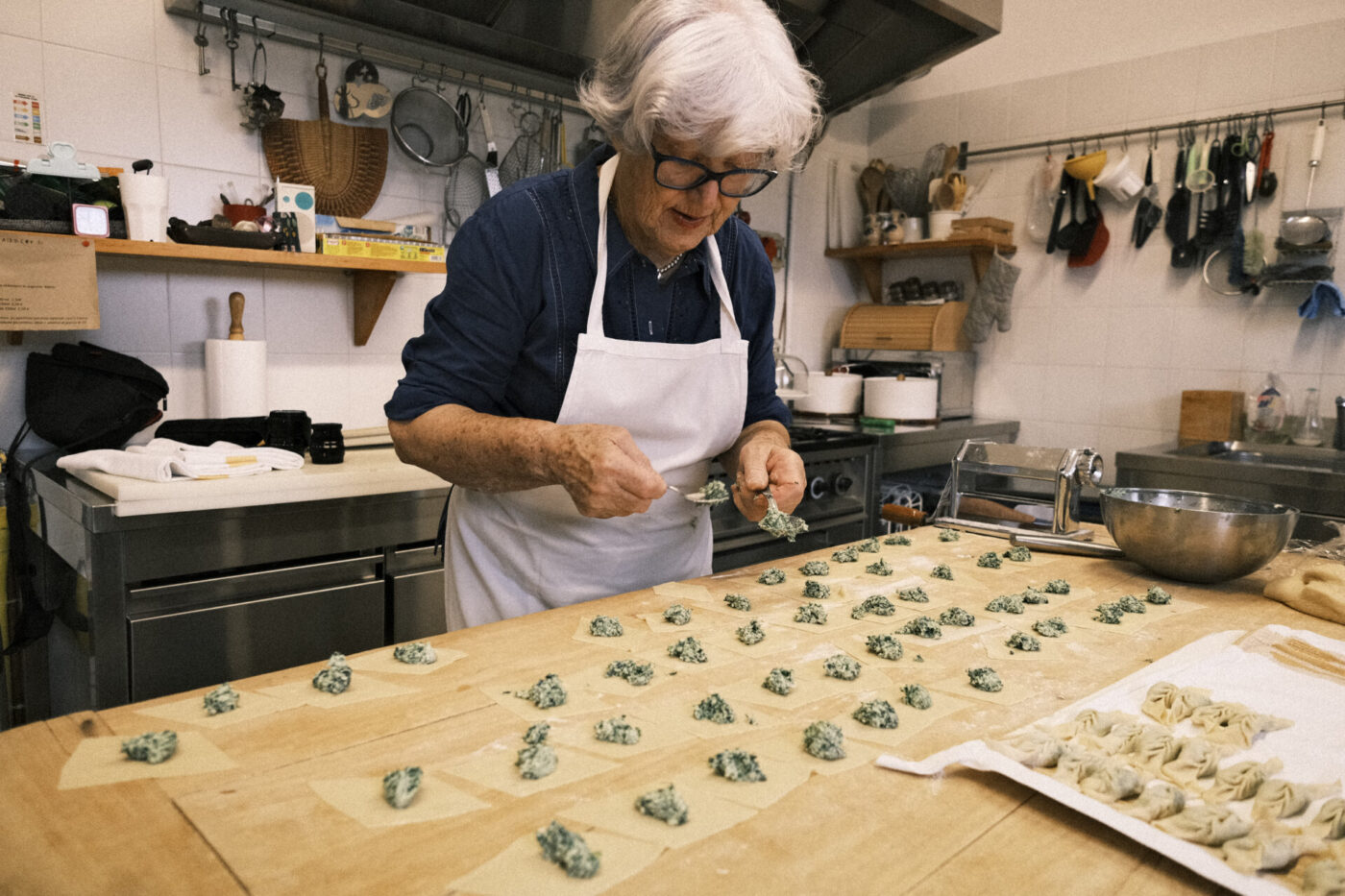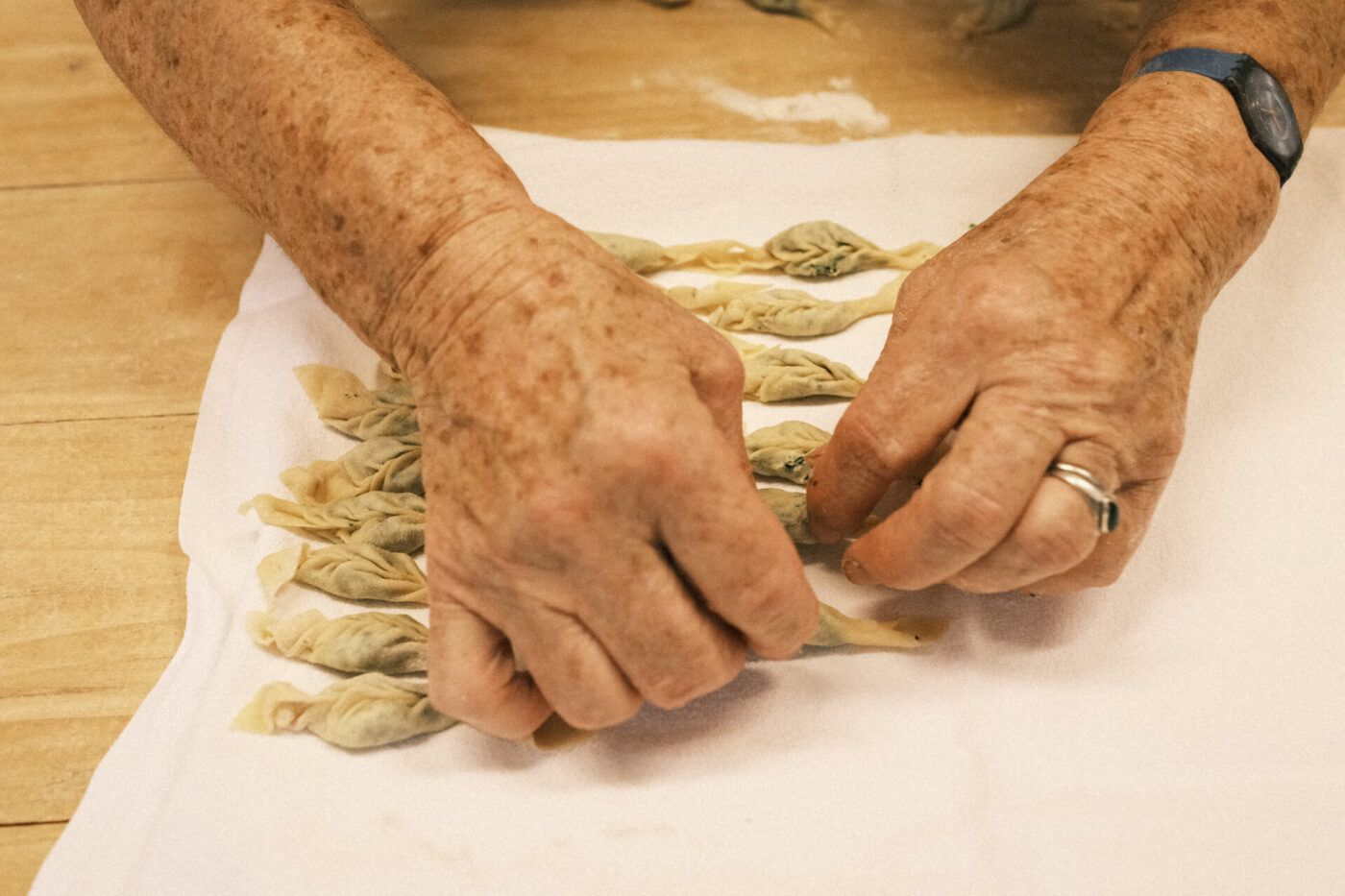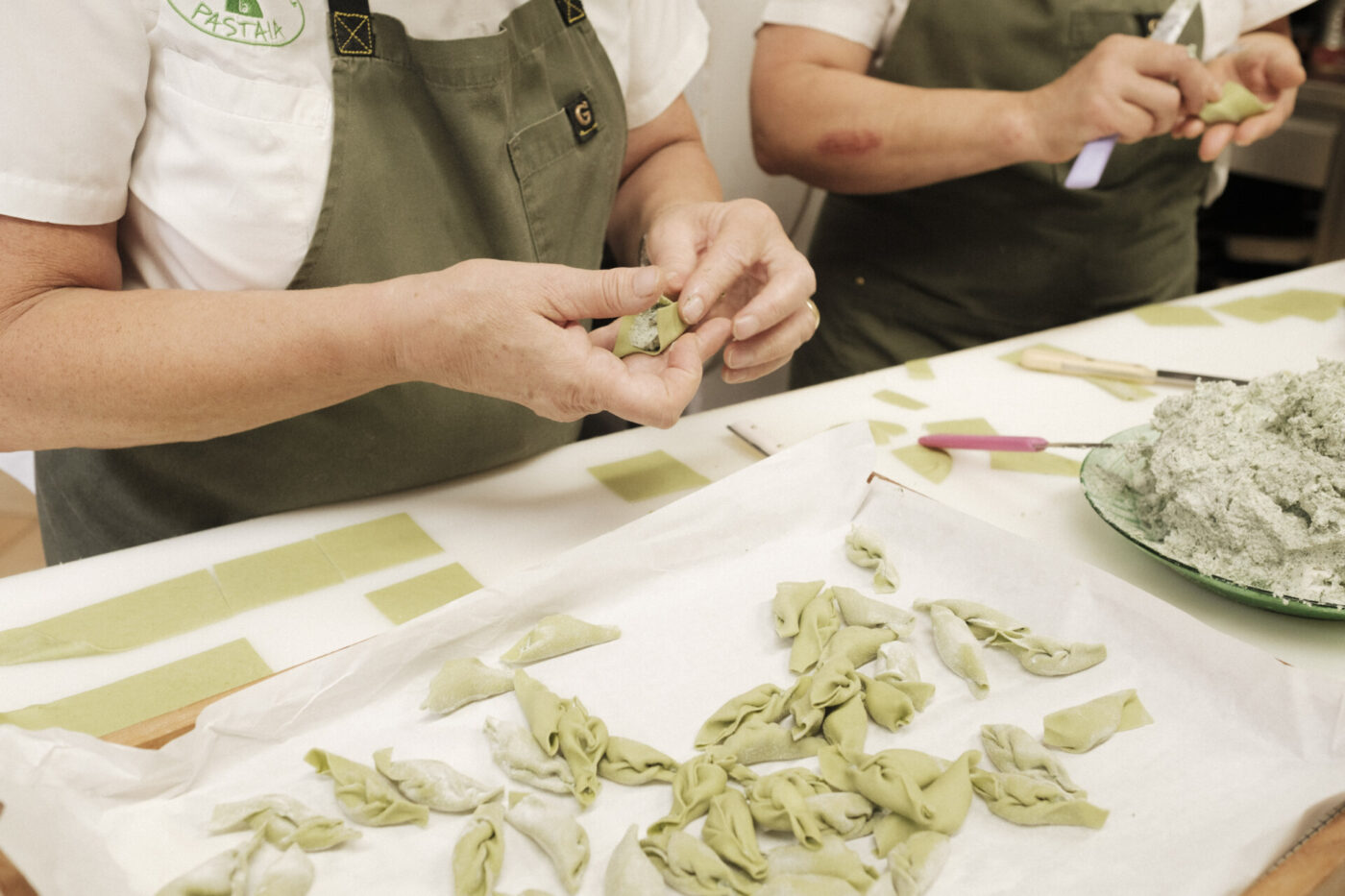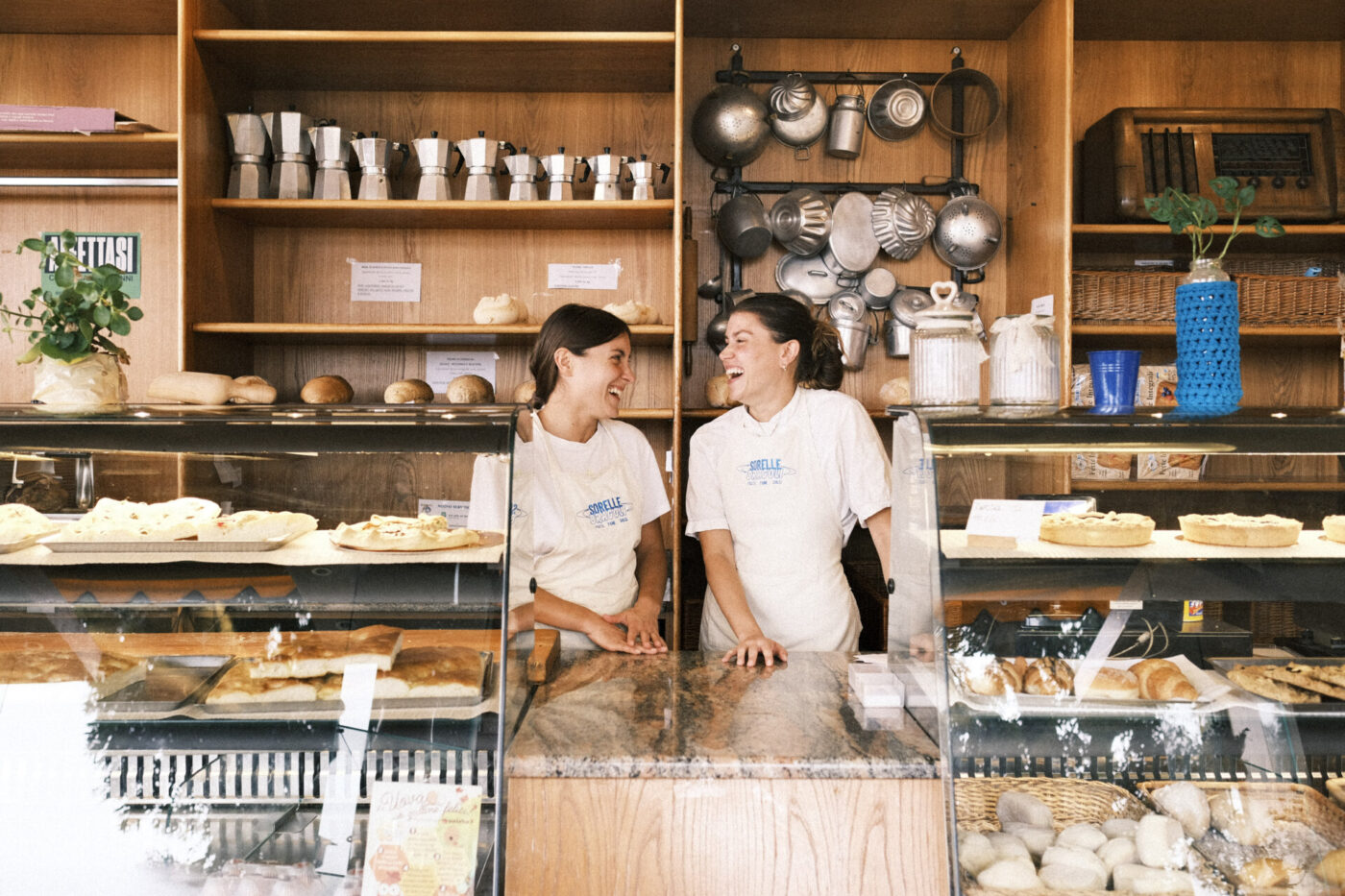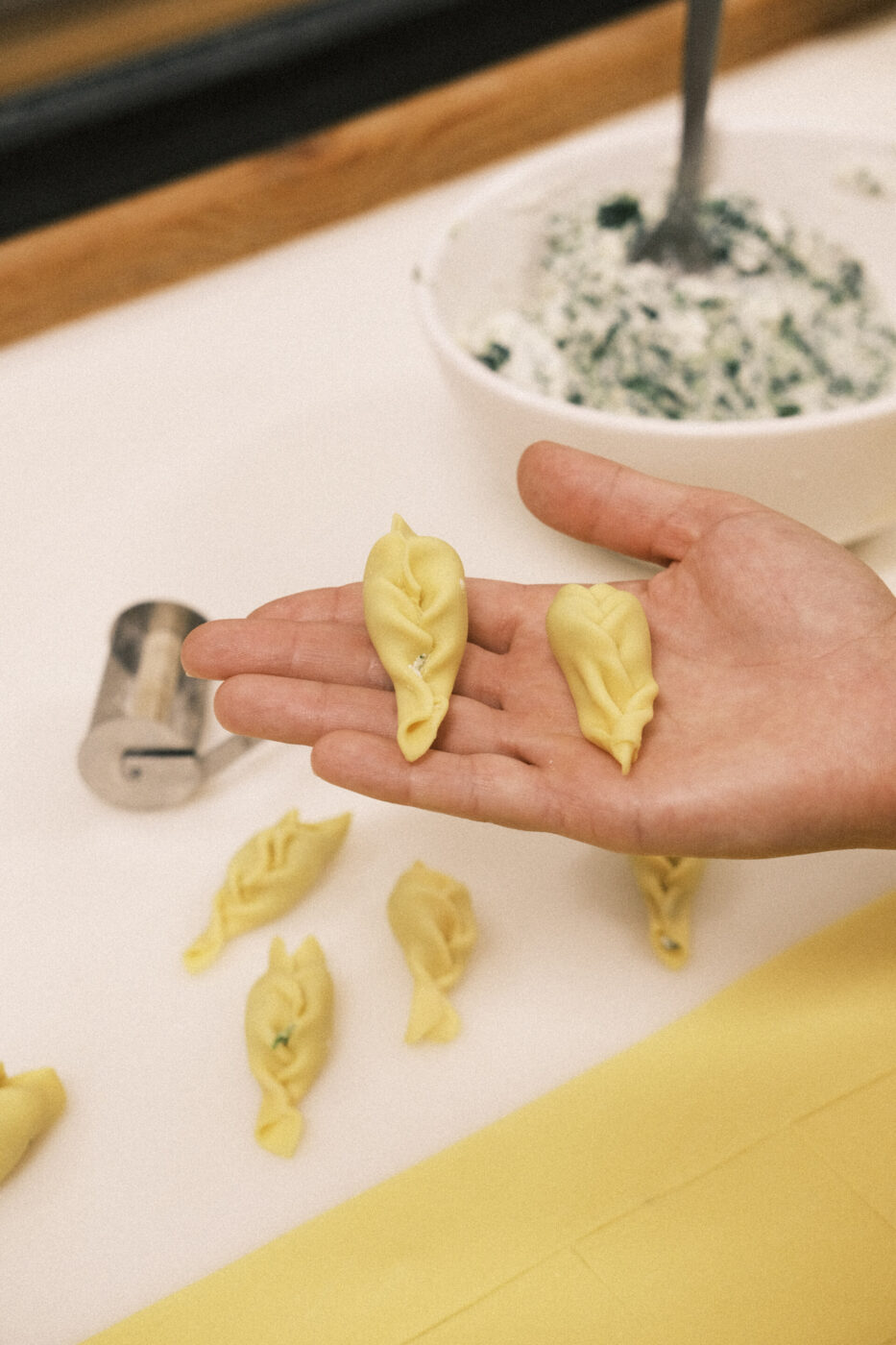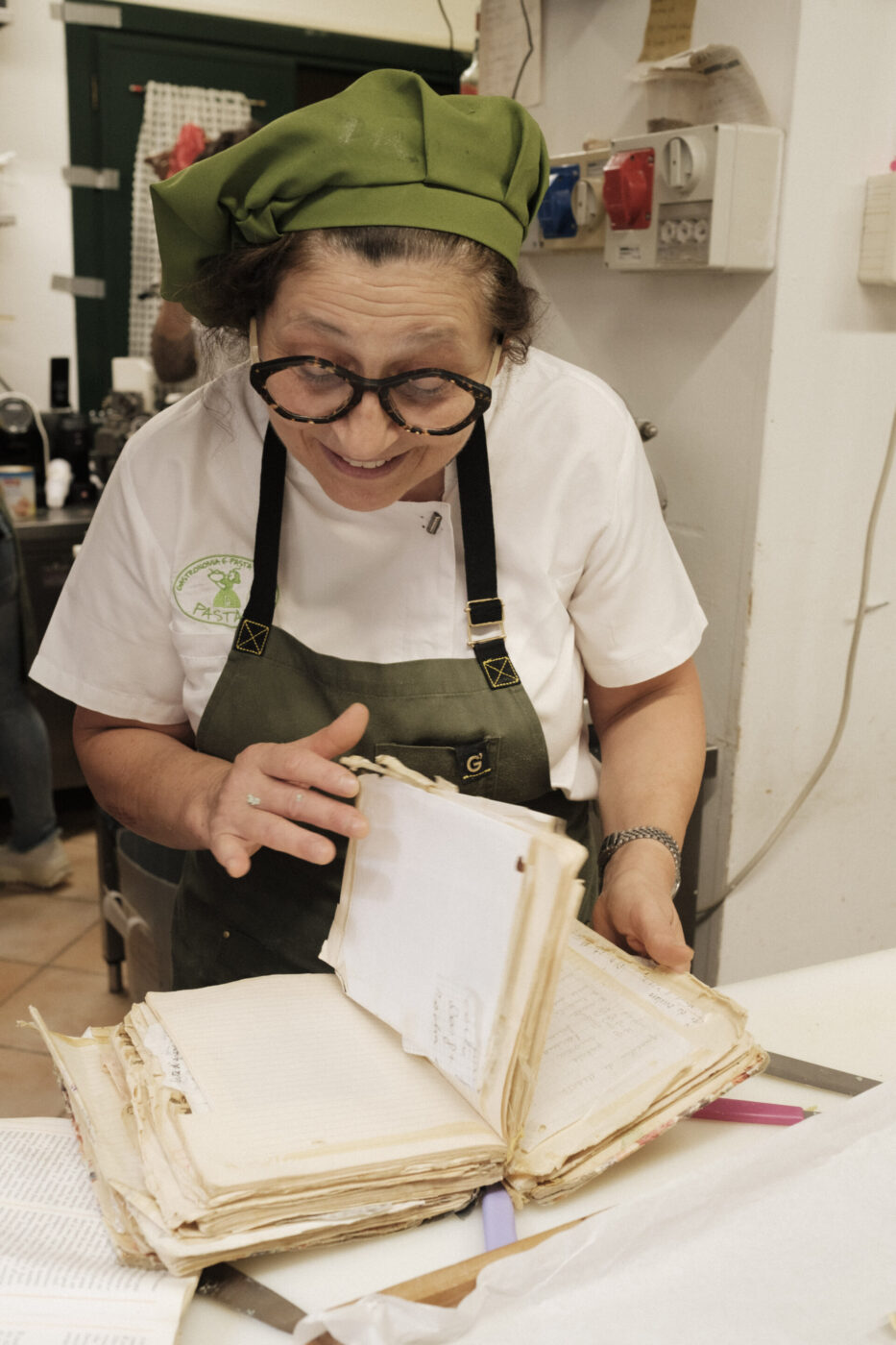Tortellini, anolini, cappellacci, cappelletti. There aren’t many things that can conjure up the image of Emilia-Romagna as well as pasta ripiena (stuffed pasta). Once the privilege of the rich and opulent–elaborate and costly fillings and extravagant, often apocryphal, origin stories were meant to transmit a sense of occasion and pomp–stuffed pasta democratized itself thanks to the economic development of the 1960s boom and slowly became the staple of most people’s diet, synonymous with home-cooked Sunday lunches, celebrations, and festivities. They pretty much all start out the same–100 grams of flour per egg, rolled out with a mattarello or pasta machine–and yet the differences in terms of shape, filling, and accompanying sauces are endless.
In Piacenza, at the far western point of the region, we make a kind of tortello that can’t be found anywhere else. Called bata-làbar by some (literally “lip-hitter” in the local dialect, because of the way it used to be eaten dangling from one’s fingers–medieval finger food), this shape of pasta ripiena is said to have been invented in the 1350s in homage to famed poet Petrarch’s visit (apocryphal, for sure). Usually filled with a ripieno of ricotta, Parmigiano, and spinach or other herbs, these little morsels are widely known as “tortelli con la coda” or “caramelle” because of their double-tailed and crumpled-candy look, respectively.
Back in the day, tortelli con la coda would be the domain of rezdôre (“housewives” doesn’t quite convey the meaning, which is closer to “home administrators”). On any given Sunday, these women would wake up early and prepare enough for lunch with their nipoti or–organized in small military-esque units–would get together and bang out kilos and kilos of them for the festa dell’unità or local sagra. It was a kind of ritual: women of different ages would gather around the kitchen table and, while catching up on the latest, prepare the dough, roll the pasta, prepare the filling, and, with great manual dexterity, fold these dumplings, ready to be boiled and served with an emulsion of butter, sage, and grated Parmigiano.
Times, of course, have changed–and thankfully so, as women’s professional opportunities have grown in the country. While grandmothers may keep preparing tortelli at home just like they used to, small botteghe and pastifici have cropped up to meet the demand of the locals who–short on the time and patience required to spend several hours making filled pasta–would still never give up a tradition that they see as part of their identity. As it happens, tortelli-making continues to be a women’s affair (and, in fact, a sisterly affair). Here, the stories of three generations of women, mostly sisters, who, whether at home or at their businesses, contribute daily efforts to keeping the tradition alive.
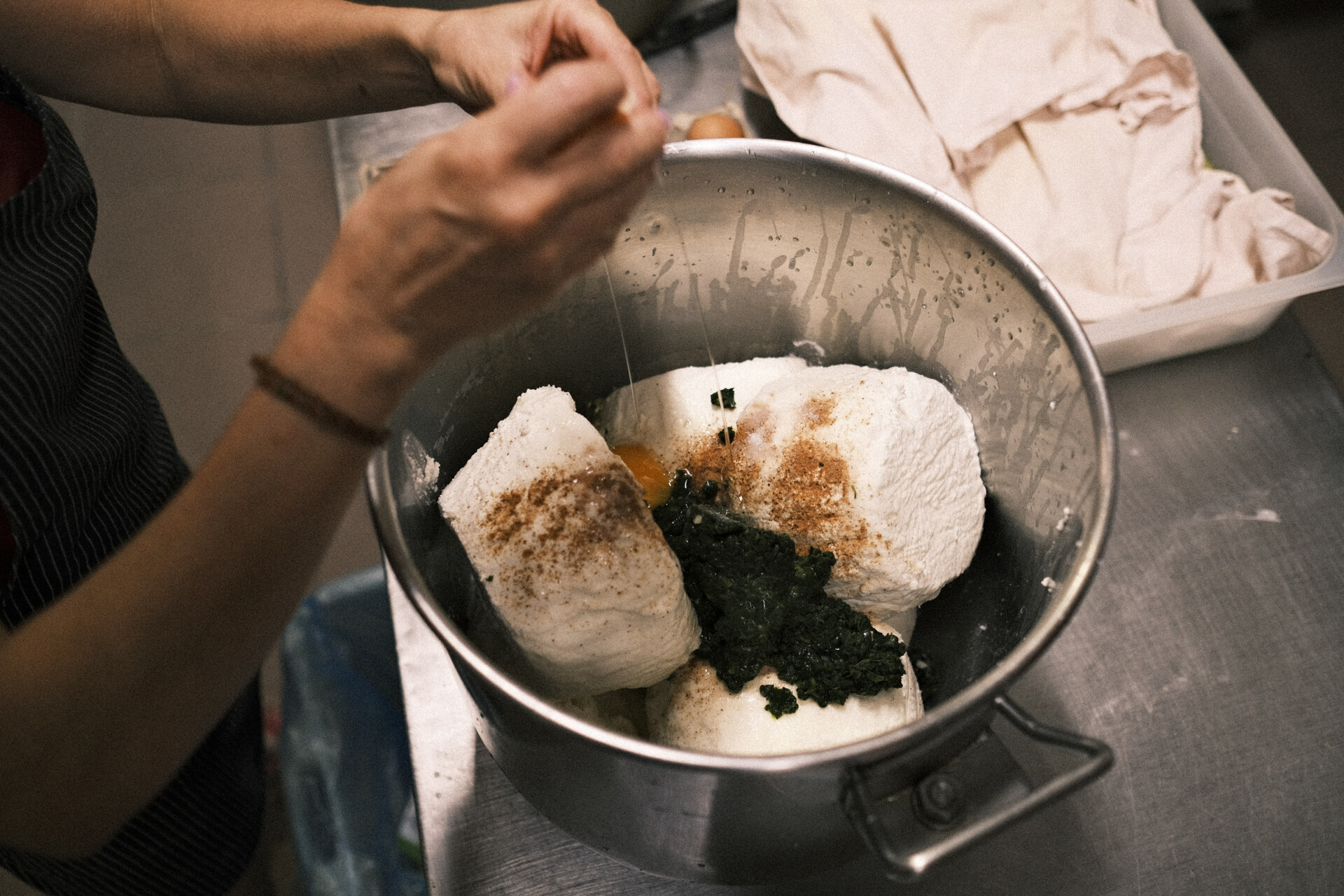
The tortelli filling
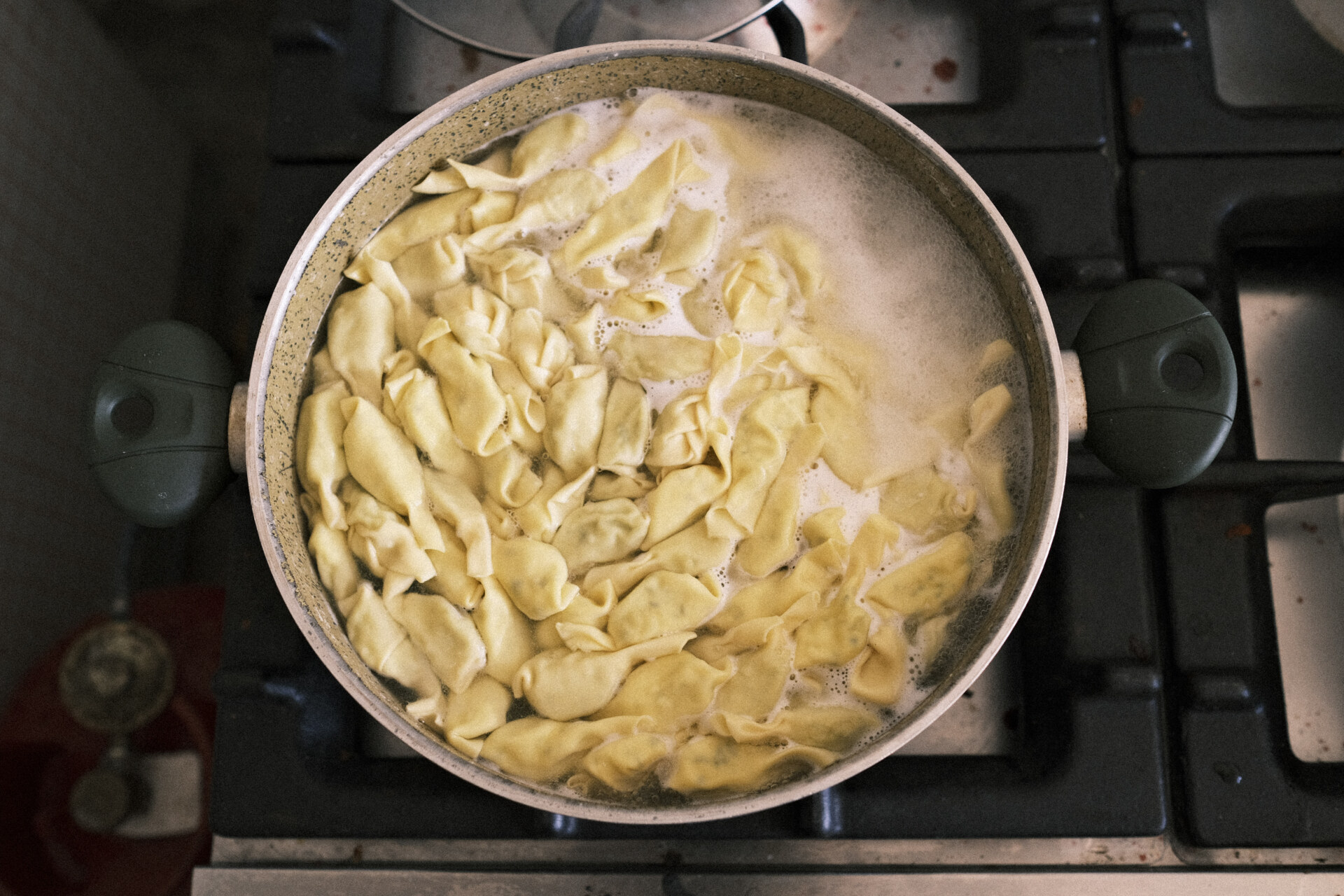
A giant pot of tortelli con al coda from Il Mattarello
Tortelli at Home: Nonna Marina
Nonna Marina (82) never liked to cook. She shakes her head as she says this. In the meantime, her hands have already arranged her ingredients on the floured spianatoia (pastry board) and her shiny old Imperia–one of the first pasta rollers–is ready to roll. Tortelli, like other types of filled pasta, and tagliatelle are a different matter. “Making pasta for me has always been a joy.”
Her house in Croara, just off the river Trebbia, has always been the heart of her family’s agriturismo, but, perhaps because she dislikes it so much, she no longer cooks for her guests. Sundays are an exception, though; the day reserved for grandchildren and meals with the whole family. “I learned to make tortelli as a child, with my grandmother. We used to wait for her to come back from the fields, and, in the evening, we would gather around the table and prepare a bit of everything.” Marina cracks jokes with a hint of pride about her working-class origins, while teasing her husband who, instead, “was born with a shirt on.” The strips of stretched pasta are waiting on the pastry board. She cuts them in small diamond shapes, ready to accommodate the filling. “For every 100 grams of flour, I put in an egg, but then everyone has their own recipe–for the filling as well.” Hers includes roughly equal parts ricotta and spinach, as well as an egg to make a good mixture; she places a little spoonful at the center of each freshly-cut square of dough.
The spianatoia is now filled with rows of yet-to-be-assembled tortelli waiting for her magic touch. Swiftly and skillfully, nonna Marina folds the corners of the dough, closes the first extremity, then makes little pinches down the length of the pasta with her index and thumb until she reaches the other extremity, which she closes to make a double-tailed candy. At lunch, there will be five people: her two grandchildren, her daughter, and her husband. As she continues making tortelli, she never stops counting. She calculates 24 or 25 tortelli per person. She kneaded 400 grams of dough; she reckons it will be enough.

Nonna Marina

La Pastaia & Il Mattarello: Le Botteghe di Paese
A few kilometers away from Nonna Marina, in Rivergaro, a dozen customers are queuing in front of La Pastaia, the village’s pastificio.
The owners Emilia and Giovanna (66 and 57) are sisters who have turned their habit of making pasta when they were young into a full-time job. It all began in 1992, when Emilia decided to open the original Pastaia not far from its current location. “It was just me and my sister at the time, and we did everything, even prepared the gastronomia.” The large counter in the front–full of elaborate primi piatti, roasts, rice salads, and lasagne, all made by them–bears witness.
When we visit on a scorching morning in early August, a customer has just come in and asked for 700 grams of tortelli; Emilia stops in her tracks, heads to the small workshop at the back, and prepares them from scratch. Churning them out at an impressively super-human speed, she tells us about the recipes, still mostly their mother’s. Though some recipes, like the lasagna and nidi di rondine (another kind of lasagna-like pasta stuffed with bechamel and ham), came from their customers, showing how the relationship between the sisters and their patrons has always been a two-way street, evolving over the course of 30+ years.
All the rolling is done with a sfogliatrice to make sure the pasta is thin enough. (The thinner and smaller the tortello, the better.) As soon as she gets a moment of respite from the till, Giovanna comes barging toward the back. She wants us to understand that good ingredients make all the difference. Local ricotta, good spinach, fresh eggs, and top-notch flour–there is no way around them. Both Emilia and Giovanna still remember when, as little girls, they would accompany their mother on walks through the neighboring countryside to forage nettles and other erbe spontanee (wild herbs) for the filling–having spinach available year-round was a later development–and, although they don’t forage as often as they used to, they still work with the same artisanal mindset and attention to detail.
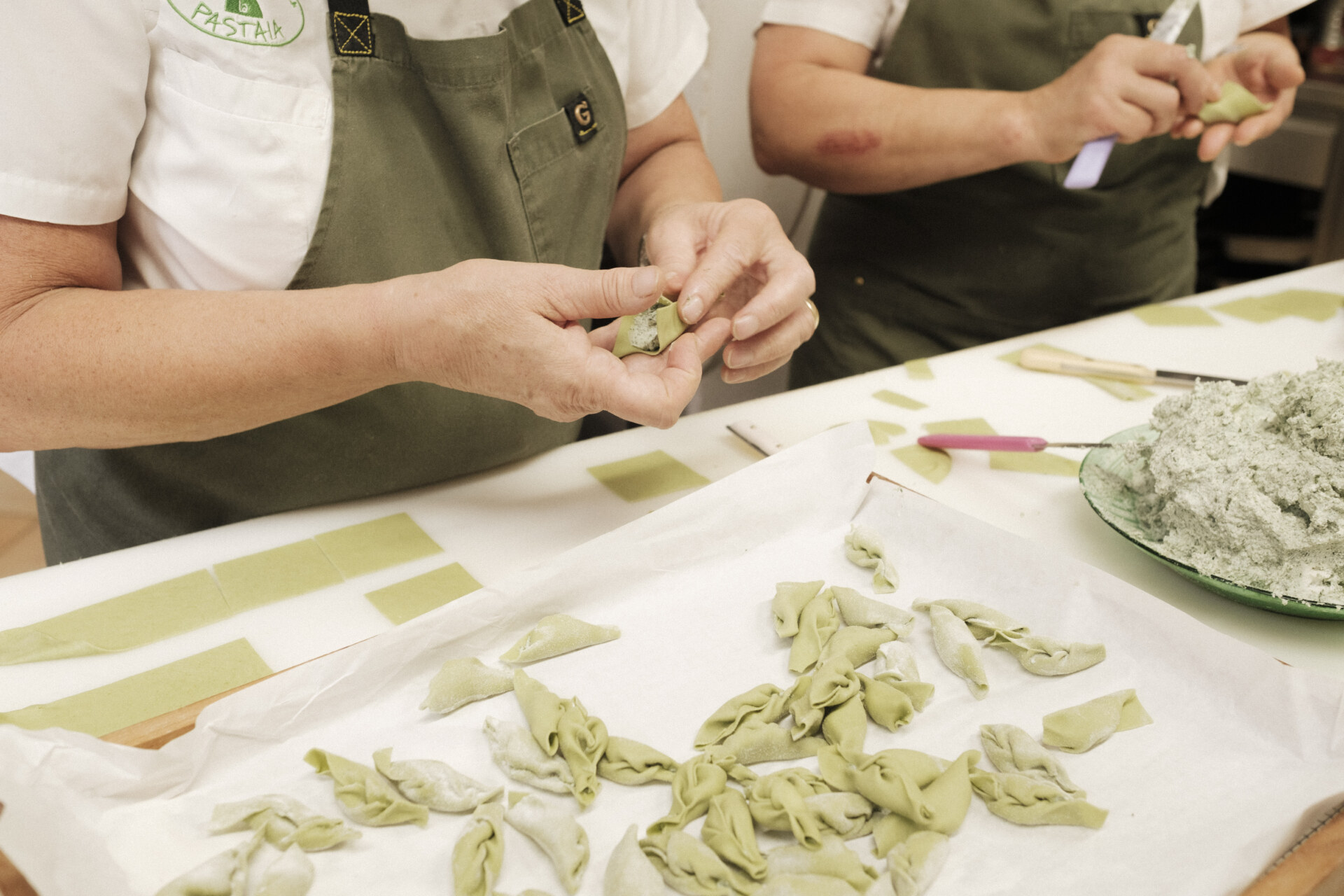
Emilia and Giovanna make tortelli
La Pastaia, with its eight employees, is the perfect example of a bottega di paese. Il Mattarello is a much bigger operation, servicing restaurants and gastronomie as far as nearby Parma, Cremona, and Milan, and yet the two establishments’ philosophies are heart-warmingly similar.
Il Mattarello has three locations–one in Carpaneto, two in Piacenza–and 18 employees which grow to a staggering 38 around Christmas time. During the holiday period, the shop roughly makes and sells 3,000 kg of tortelli and 5,000 kg of anolini, Piacenza’s answer to tortellini. It brings to mind Boccaccio’s paese del bengodi, that mythical land where people, atop a mountain of grated Parmigiano, feast on ravioli and tortelli swimming in capon broth. Apart from machines meant to streamline some stages of the process, these massive numbers are all still achieved by hand; the tortelli’s elaborate, highly-sensitive form of folding and pinching cannot be replicated satisfactorily by a machine. (There are at least a dozen different movements that must be executed with exceptional adroitness in the tortello con la coda process, all of which makes creating a machine fit for the purpose an unnecessary headache.)
The owners, Emanuela (61) and Elena Antonelli (60), grew up on a small-holding farm in the hills of Carpaneto; like Emilia and Giovanna, as children, they would accompany their mother foraging and help her make pasta ripiena on special days. (Elena, now retired, has made a vow to revive the farm and spends most of her time tending to the vegetable garden and making jams to be used in the shop.) Back then, tortelli or anolini were every-so-often dishes, rather than the go-to meals they’ve become today. Around the 1980s and ‘90s, Emilia-Romagnans stop returning home for lunch and the desire for food that could be prepared quickly, but still conveyed a sense of family and tradition, grew–as did the number of bars and restaurants that had to feed this burgeoning workforce every pausa pranzo. In 1990, Elena and Emanuela, who had been working various factory jobs, decided to open a pastificio to meet the demand.
As it happens, we are regulars of Mattarello–avid consumers of their pasta fresca as well as their other signature dish, torta di patate, a traditional rustic pie with a potato and cheese filling which, for years, has been our aperitivo snack of choice. Yet, until now, we’ve never had the cheek to ask to visit the workshop at the back.
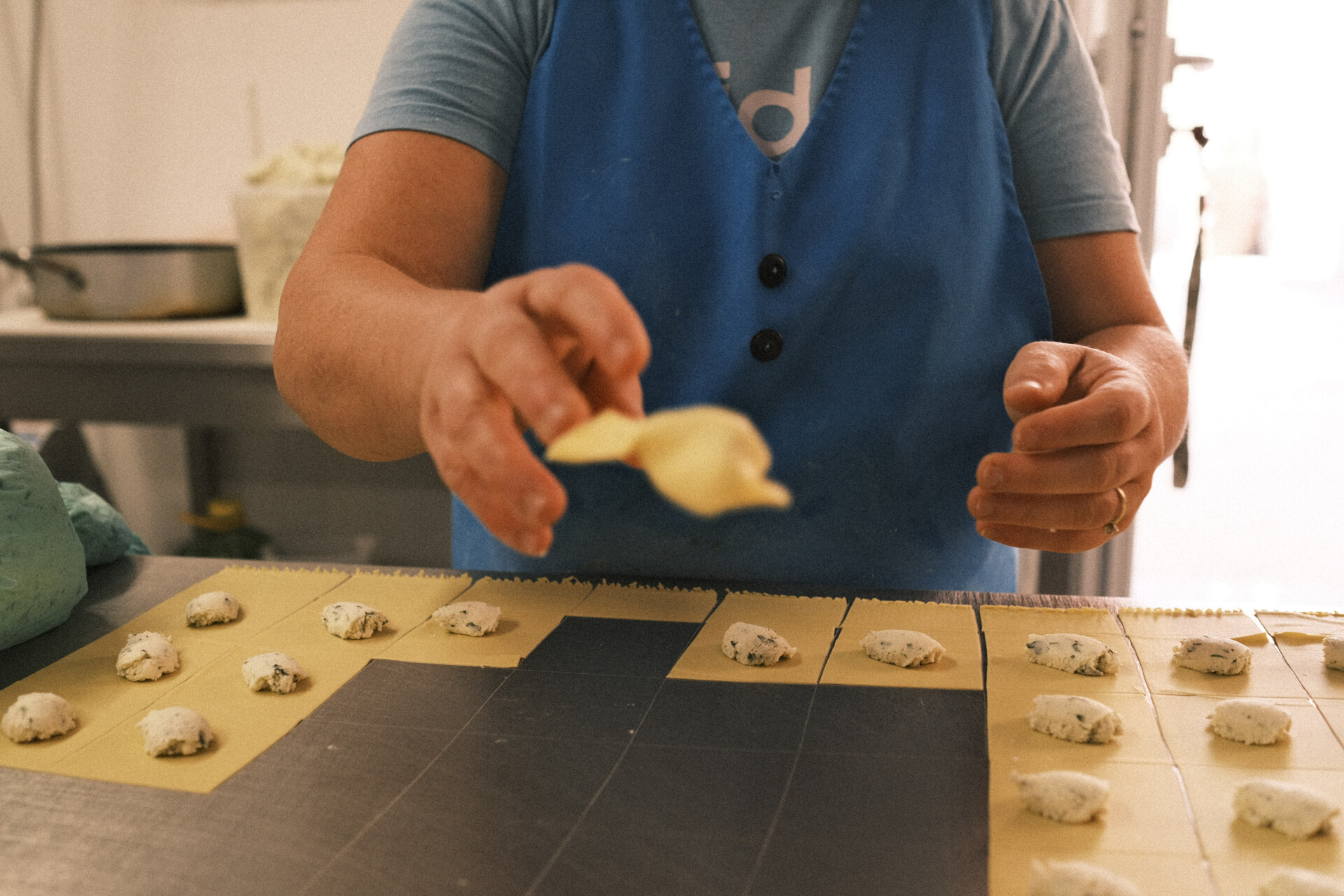
We arrive at the headquarters one early morning in late August–but not as early as Emanuela and her team of women, who have been busy since 4:30 AM. In the kitchen, just off the back of the shop, her two long-time employees Clara (55) and Cesarina (50) are working through various preparations such as pasta doughs, fillings, cakes, and sauces for the shop and gastronomia.
Once the filling of the tortelli–which includes Grana cheese and a couple of eggs–is ready, we move to the laboratory proper. There, we meet Liliana (50s) and Zamira (50s), in charge of making tortelli that day. (Everything is made to order, and so employees often shift from one task to another to keep up with demand.) They roll the dough out, cut it into squares with a bicicletta (dough cutter), place the filling with a piping bag, and close the tortelli. Liliana is Romanian and has been at Mattarello for less than a year. Previously, she worked at a restaurant where she also learned how to make pasta fresca, but she much prefers what she calls “autogestione”, that is, the possibility for self-management that working at a lower pace affords. Zamira is Albanian and much shier, but has been there for roughly four years and is considered by all the best sfoglina. Alone, she can bash out around five kilos of tortelli in less than an hour, although, like Liliana, she is not very fond of eating them. “I have got my own stuff,” she says with a laugh.
As we observe and nag them with our silly questions, we realize that each has a slightly different technique. One woman’s tortelli have more of a pot belly, while the other’s have only one tail and so resemble little fish. “It’s like a fingerprint, everyone has their own personal one,” says Andrea (29), Emanuela’s son, our friend, and our guide for the day.
Together with his twin brother Marco (29) and his younger brother Erwin (17), Andrea is set to inherit the business and has big ideas on how to expand it. He’s cast his eyes on Milan, but like his mother and aunt who still use his grandmother’s recipes, he knows the secret of the shop is held at the old farm. “I wish there was a way to grow the bulk of the produce we use at the shop here,” he says when we drive up to the azienda that’s been his family’s for two generations.
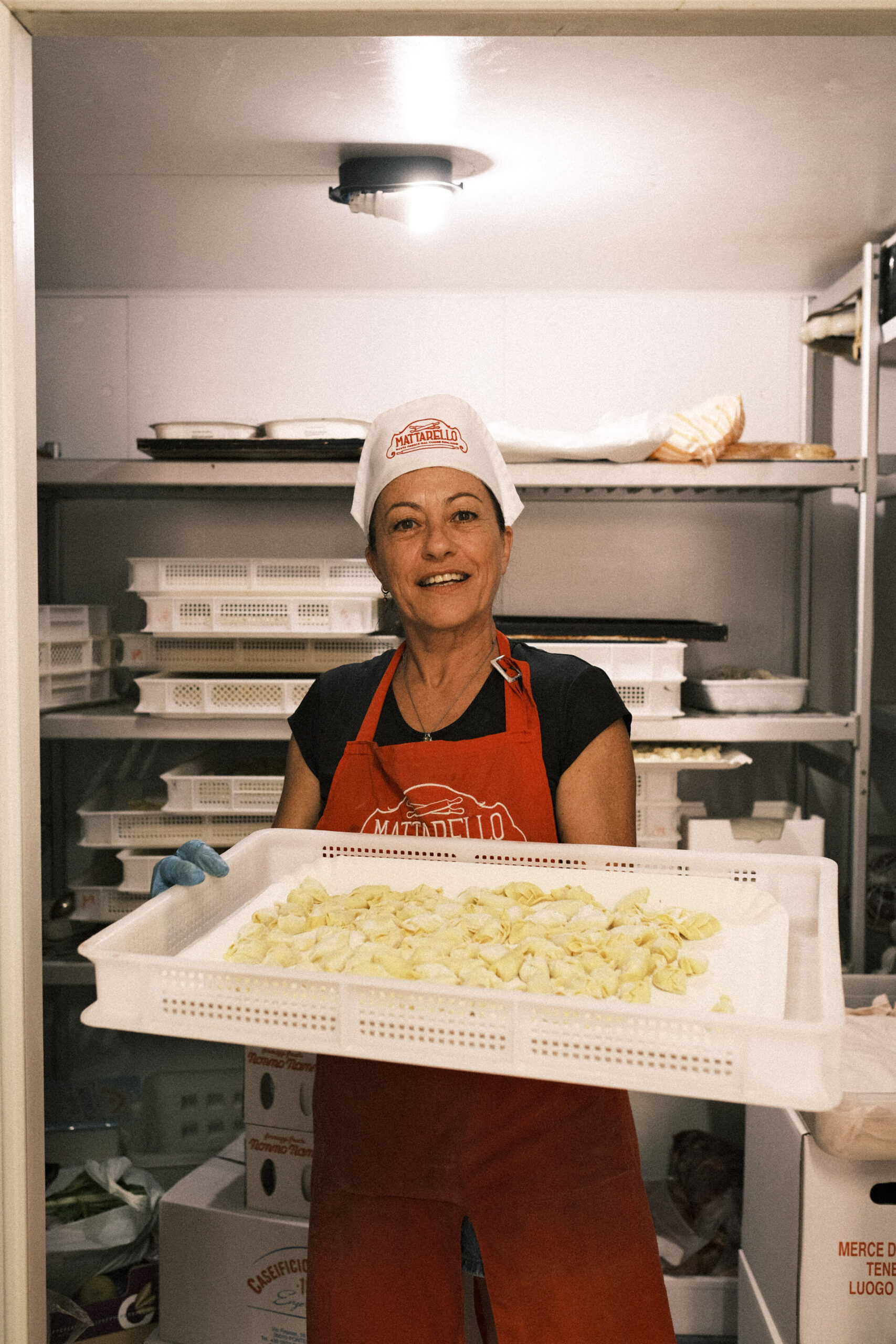
In the kitchen at Il Mattarello
Sfogline 2.0: Le Sorelle Bragoli
Andrea and Marco are not the only young people in the business of pasta fresca. Embedded in the working-class neighborhood of Sant’Antonio, not too far from the Cooperativa Sant’Antonio, Sorelle Bragoli was born of the pandemic, which saw many ditching their unfulfilling jobs to chase what truly excites them and dive into time-intensive culinary techniques they might never have attempted before. “We always fantasized about setting up something together, maybe a restaurant, because we loved to cook with our dad,” says Eleonora (32), the eldest Bragoli sister. “But we never thought it would be a pasta business.”
The idea came to her and her sister Isabella (29) during Covid when, laid off from their jobs, the two found themselves banging out anolini from a makeshift workshop they created in their family home in Viustino, near Carpaneto. Unlike Eleonora, who studied communication, Isabella went to alberghiera–Italy’s vocational school for cooks and other hospitality professionals–and had been a sfoglina for three years at Eataly. After working various jobs in the industry, she realized the hectic pace of restaurants wasn’t for her and that having a pasta shop would be a great way to exercise her skills and further explore pasticceria, her true passion.
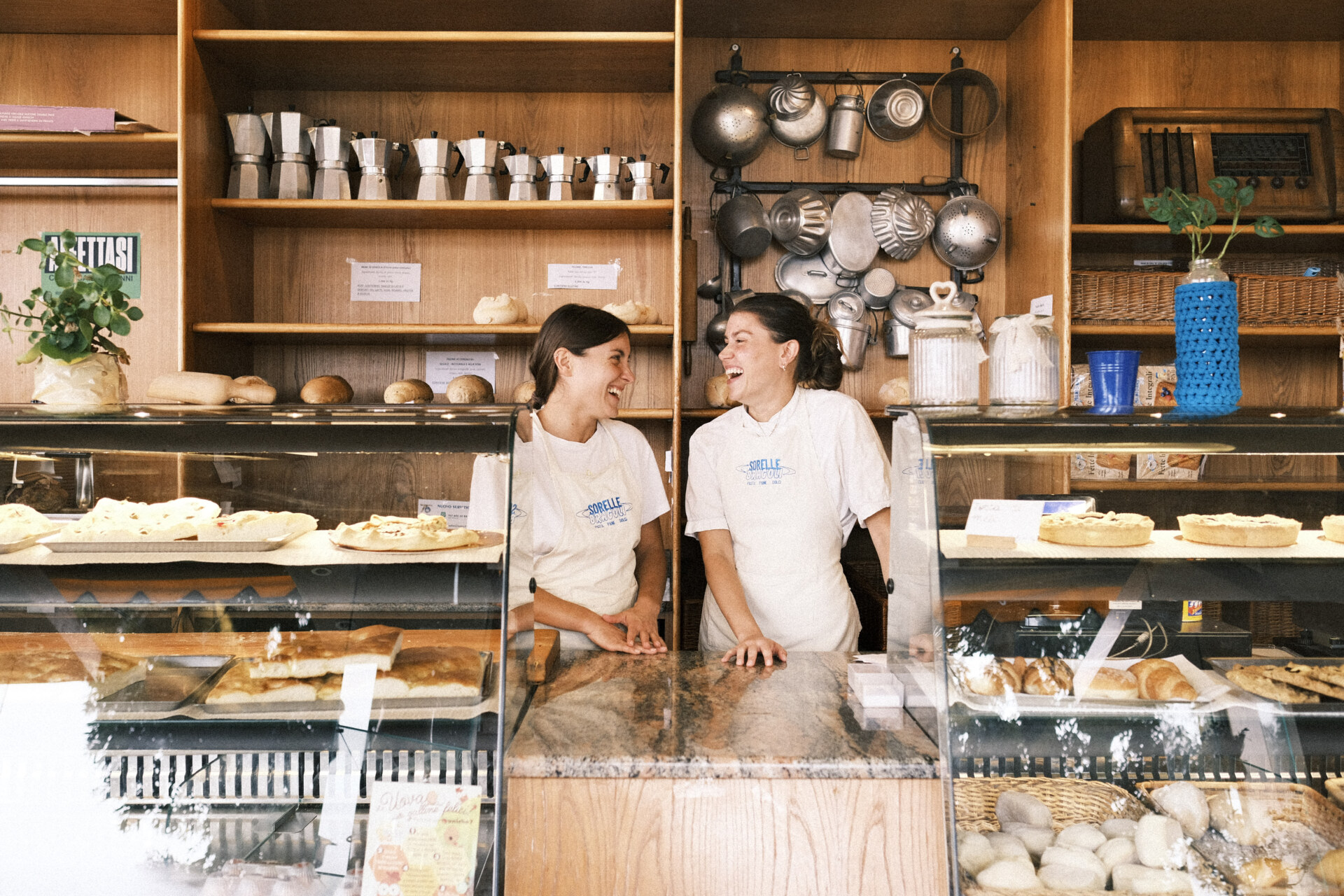
Le Sorelle Bragoli
The sisters have been open for business since August 2020, when they took the shop over from the previous owner. Just a few hours at the shop makes it immediately clear how much a part of the community they’ve become. Despite the dreadful early September weather, people keep pouring in, and Eleonora and Isabella greet them all by name.
Our conversation turns to the subject of the hipster rediscovery and romanticisation of those jobs which in Italy are called mestieri umili–vocational, artisanal professions such as that of pasta maker or baker. Eleonora and Isabella don’t really have an answer as to why this has been the case: “It might all blow over, but let’s hope not!” says Eleonora. For their part, they’re adamant about keeping things as they remember them and holding the marketing and fussy revisitations to a minimum. “Agnolotti del plin with mustard reductions aren’t really our style,” she adds. This might seem like a conservative approach, but it makes perfect sense when you step into their alimentari and workshop–a time capsule of the 1970s.
Although Eleonora and Isabella have opened themselves to new trends such as pasta workshops and private cooking classes, the bulk of their business comes from people in the neighborhood buying pasta and stopping in for a chat. What good would come from alienating them? Or worse, pricing them out? By cherishing what’s good about the past, they’re building a future for themselves they could have scarcely imagined only a few years ago.


